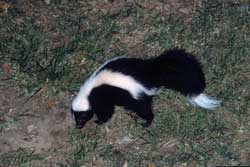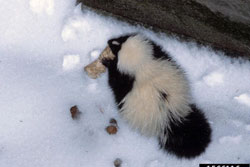Home → Pests → Other Critters → Skunk
Striped Skunk—Mephitis mephitis
Skunks are members of the weasel family; the most common is the striped skunk. They are omnivores, eating insects, small mammals and birds, crustaceans, fruits, grasses, leaves, buds, grains, nuts, and carrion. Insects make up approximately 70% of their diet.
Skunks become pests when their burrowing and feeding habits conflict with humans. They burrow under porches or buildings; they disturb garbage left outdoors; they damage beehives by attempting to feed on bees; they occasionally feed on corn; and, of course, they often leave behind a distinct odor. They are valuable, however, in helping to control insect and rodent populations.

The striped skunk is characterized by prominent, lateral white stripes that run down its back. Its fur is otherwise jet black. The striped skunk is about the size of an ordinary house cat, up to 29 inches long and weighing about 8 pounds.
Click on images to view full-size
Identification and Control Information
- Skunks—Maine Department of Inland Fisheries & Wildlife
- Wildlife Damage Control: Skunks (PDF)—Penn State College of Agricultural Sciences Cooperative Extension
- Vermont Wildlife Fact Sheet: Striped Skunk (PDF)—Vermont Fish & Wildlife
- Wildlife Damage Management Series: Skunks (PDF)—Utah State University Cooperative Extension
- Wildlife Damage Management Fact Sheet Series: Striped Skunks (PDF)—Cornell Cooperative Extension
- Prevention and Control of Wildlife Damage: Skunks (PDF)—Internet Center for Wildlife Damage Management
More Information
- Preventing and Dealing with Nuisance Wildlife Encounters (PDF)—Ohio Department of Natural Resources
- Dealing with Nuisance Wildlife (PDF)—University of Maryland Cooperative Extension
[Photos: Alfred Viola, Northeastern University, Bugwood.org]
